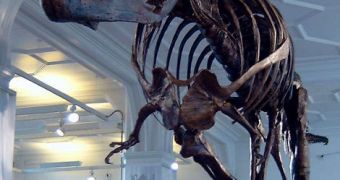In addition to having a keen, motion-based vision, strong feet and sharp teeth, it would appear that Tyrannosaurs Rex also boasted the ability to run very fast, a lot more so than researchers first gave it credit for.
The conclusion is based on a new study of the dinosaur's backside. Researchers determined that the animal sported some of the strongest tail muscles known, and argue that they allowed the reptile to run very fast for its size.
In all likelihood, T. Rex was the scourge of the Cretaceous, hunting both small and large herbivore dinosaurs, as well as the occasional carnivore, if the opportunity presented itself. Thus far, researchers believed that the animal had a tough time catching prey that could run swiftly.
But the new investigation proves that this concern was unfounded. T. Rex could apparently face nearly any challenge its competitors could throw its way. The study even suggests that the lizard could outrun every other dinosaur.
One of the reasons for why the tail muscles are so important in this is the fact that they are used to help the tail counterbalance the enormous weight of the animal's giant head. The dinosaur had a small brain, but a very large cranium, as well as large and powerful jaws.
“Contrary to earlier theories, T. rex had more than just junk in its trunk,"” explains University of Alberta graduate student and study researcher Scott Persons. He is part of the team that analyzed the dinosaur's tail muscles.
The Canadian group compared the results with analyses of the Tails of modern reptiles, including veiled chameleons, green iguanas, crocodiles, brown basilisk lizards and Komodo Dragons. This was done by performing a necropsy on each of the living animals.
The team was essentially looking to discover where muscles inserted on the bones of the reptiles. Finding these so-called insertion points was important because they could then compare the findings with those made on T. Rex fossils.
The end goal for all this was to be able to construct the musculature of a ancient dinosaur without having any of the muscles available – in other words, relying only on the bones for the job, LiveScience reports.
The largest tail muscle was found to be the main femoral retractor muscle, called the M. caudofemoralis longus, which is generally attached to the femur of reptiles. This is most likely how T. Rex's musculature looked like too.
“While most of the muscles in the tail are responsible for swishing, curling and stabilizing the tail – they're involved in tail movement – the primary function of M. caudofemoralis is in locomotion,” Persons explains.
Data derived from the new study shows that the mass of this particular muscle in T. Rex may have been underestimated by as much as 45 percent. Considering the large role it plays in locomotion, it stands to reason that the dinosaur was most likely able to propel itself very fast.
“It looks like T. rex was suited to outrun all the other dinosaurs in its environment,” Persons adds. The bulkier muscle also imply that the dinosaur was a lot more stable than previously thought. Details of the study appear in the latest issue of the respected journal The Anatomical Record.

 14 DAY TRIAL //
14 DAY TRIAL //